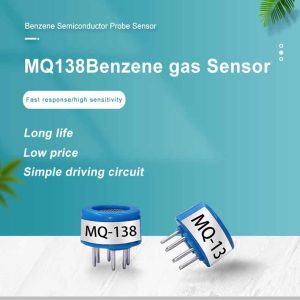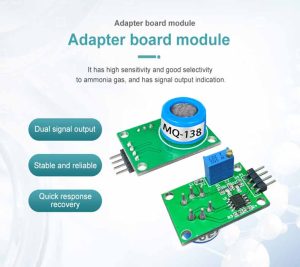-
Enhancing Air Quality Monitoring with Gas Sensors: A Step towards Healthier Environments
- Air pollution is a global concern that poses significant risks to human health and the environment. With the rapid industrialization, urbanization, and increased vehicular emissions, monitoring air quality has become crucial for creating ……
- Chat Online
-
Description
Air pollution is a global concern that poses significant risks to human health and the environment. With the rapid industrialization, urbanization, and increased vehicular emissions, monitoring air quality has become crucial for creating healthier living environments. In recent years, gas sensors have emerged as powerful tools in assessing air quality by detecting and measuring various pollutants. This article explores the importance of gas sensors in enhancing air quality monitoring and their role in creating healthier environments.
Understanding Gas Sensors
Gas sensors are devices designed to detect and measure the presence and concentration of specific gases in the air. They utilize a variety of technologies, including electrochemical, photochemical, and semiconductor-based techniques, to provide accurate and real-time data. Some commonly measured pollutants include carbon monoxide (CO), nitrogen dioxide (NO2), ozone (O3), sulfur dioxide (SO2), particulate matter (PM), and volatile organic compounds (VOCs). Gas sensors are essential tools for evaluating air quality, identifying sources of pollution, and assessing the effectiveness of air pollution control measures.
Real-time Monitoring and Continuous Data Collection
One of the key advantages of gas sensors is their ability to provide real-time monitoring of air pollutants. Traditional air quality monitoring methods often involve periodic sampling and laboratory analysis, which may not capture immediate changes in pollutant levels. Gas sensors, on the other hand, offer instant data, enabling timely responses to fluctuations in air quality. This capability is particularly valuable in detecting sudden pollution events, such as industrial accidents or wildfires, and allows authorities to take immediate action to minimize the impact on public health.
Identifying Pollutant Sources and Patterns
Gas sensors play a crucial role in identifying pollutant sources and patterns in urban areas. By continuously measuring pollutant concentrations at multiple locations, these sensors can help localize pollution hotspots and determine the sources of emissions. For example, elevated levels of nitrogen dioxide near roadways may indicate high vehicular emissions, while increased particulate matter concentrations in industrial areas may suggest the presence of industrial pollution sources. By understanding the sources and patterns of pollution, policymakers can implement targeted measures to reduce emissions, improve air quality, and protect public health.
Air Quality Index and Health Alerts
Gas sensors contribute to the calculation of the Air Quality Index (AQI), which provides an assessment of air quality and its potential health effects. Based on measured pollutant concentrations, the AQI categorizes air quality into different levels, ranging from good to hazardous. Gas sensors play a crucial role in monitoring the pollutants that contribute to the AQI and provide the data needed for accurate calculations. The AQI helps authorities issue health alerts and advisories, enabling individuals to take necessary precautions, such as reducing outdoor activities or wearing respiratory protection, to minimize health risks associated with poor air quality.
Early Warning Systems and Mitigation Measures
Gas sensors are instrumental in the establishment of early warning systems for detecting sudden increases in pollutant levels. By continuously monitoring air quality, these sensors can detect spikes in pollutant concentrations, even before they exceed official air quality standards. Early warning systems allow authorities to take immediate mitigation measures, such as implementing traffic restrictions, adjusting industrial emissions, or activating emergency response plans. These proactive measures can effectively control pollution episodes and prevent adverse health effects among vulnerable populations, such as children, elderly individuals, and those with respiratory conditions.
Improving Urban Planning and Design
Gas sensors offer valuable insights for urban planning and design strategies aimed at improving air quality. By providing real-time and location-specific data on pollutant concentrations, these sensors enable policymakers to identify areas with poor air quality and prioritize interventions. For instance, the data collected by gas sensors can inform decisions regarding the placement of green spaces, pedestrian zones, and bike lanes to promote non-polluting modes of transport and reduce vehicular emissions. Integrating air quality monitoring into urban planning efforts can create healthier and more sustainable cities for residents.
Public Awareness and Citizen Engagement
Gas sensors have the potential to raise public awareness and encourage citizen engagement in air quality monitoring efforts. By providing real-time data on pollutant levels, these sensors enable individuals to make informed decisions about their daily activities and take necessary precautions to pr
-
Recommend:
-
-
Gas detectors are crucial devices used in various industrie…
-
How do gas detectors ensure industrial safety?
Gas detectors play a crucial role in ensuring the safety of…
-
How Gas Sensors Help Combat Air Pollution?
Air pollution is a pressing global issue that poses signifi…
-
How can gas sensors be used in air quality monitoring?
Air pollution is a significant global concern that affects …
-
 : +86 155 8830 2704
: +86 155 8830 2704 : jxdziot@gmail.com
: jxdziot@gmail.com
